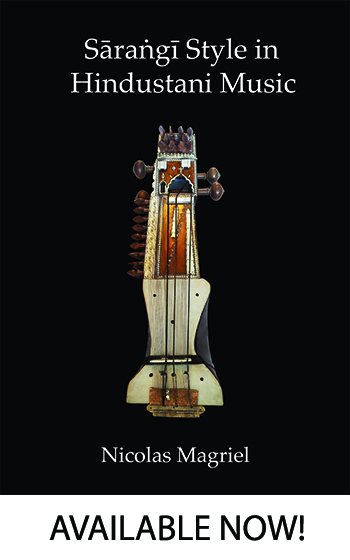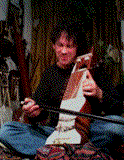
I began learning sarangi in the end of 1970 from Ustad Sabri Khan in Delhi. I went on to learn from the great Pandit Gopal Mishra and his brother Pandit Hanuman Prasad Mishra of Banaras. Other cherished teachers have been Ustad Abdul Latif Khan in Bhopal, Ustad Mohammed Ali Khan and Ustad Ghulam Sabir Qadri in Delhi, Pandit Baccha Lal Mishra and Ustad Zakan Khan in Banares. My main teachers of vocal music have been Pandit Dilip Chandra Vedi in Delhii, and Ustad Aslam Khan and Pandit Batuk Dewanji in Bombay. Fot detailed information about my talim and my musical journey please see the Nicolas Magriel page, accessible from the Home page of this site.
I have decided to add this page recently, and will gradually include film clips of my performances on TV during the 1980s and other old films which are now buried elsewhere on this site: (in Other Gems: Miscellaneous Videos).
To begin with, my most recent performance—on March 2nd, 2016 at the Nehru Centre, the cultural wing of the Indian high Commission, in London. I was accompanied by my good friend Jhalib Millar, a student of Ustad All Rakha Khan, on tabla.
To emphasise that sarangi usually plays vocal music, I introduced each rag with the poetry of the bandishes which I played. The first three videos below have all the introductions and tuning omitted. Thiese are followed by the same three videos with my talking and tuning included.
Unfortunately the tambura drone was far too loud—I'm sorry about this! It was somewhat quieter on the second and third pieces.
I began with rag Maru Bihag. I played two khayal compositions, learnt from Pandit Bhimsen Joshi: the famous "rasiya ho" in vilambit ektal and "tarapat rain din" in drut tintal:
The next piece was rag Vediki Lalit, a rag which was invented by Dilip Chandra Vedi in 1934 when he performed it at the All India Music Conference on the same stage as other stalwarts such as Ustad Faiyaz Khan and Pandit Om Karnath Thakur. Two compositions "joban jaat" adapted to vilambit tintal and "nainavaa ki tir" in drut tintal. This item had more "instrumental elements" such as tabla improvisations in the vilambit section and ati-drut jhala as the conclusion.
The performance concluded with a purab ang-style bol banao thumri in Mishra Khamaj: "mad he bhare tore nain" as learnt from Padmavibhushan Girija Devi:
The following links will show you the same three videos including all my talking (mainly the poetry of the bandishes) and tuning:



